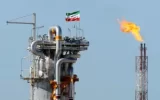Where is Iran in the Middle East gas revolution?

According to Energy Press; The Middle East, long known for its vast oil reserves, is now experiencing a significant shift towards natural gas. Faced with rising domestic demand, global energy security concerns and the urgent need to reduce carbon emissions, several key countries in the region, such as Iran and Saudi Arabia, are embarking on ambitious gas development projects. The region’s gas consumption grew by 4.7% in 2023, driven by the growth of industrial zones and petrochemical businesses. This upward trend is expected to continue, with consumption increasing by almost another 4.7% in 2024. To meet this growing demand, the Middle East will add 26 billion cubic meters of gas, mainly from projects such as South Pars in Iran and Khazan-Makarim in Oman. In recent years, the use of gas in the Middle East has expanded as an alternative to oil and its products in many sectors, supported by national policies aimed at creating major changes in the energy mix by the end of the decade. Saudi Arabia, Iraq, Kuwait and Iran are leading the shift towards natural gas in the Middle East, particularly in power generation.
The rise in gas use in the Middle East comes amid a growing global shift towards this source instead of oil and more polluting coal in power, transport and other sectors. In China, for example, LNG truck sales hit a new record in 2024, helping to reduce demand for diesel. The number of LNG ships in the shipping sector is also expected to double to 1,200 by 2028.
Saudi Arabia’s Leading Role
Saudi Arabia has plans to use Middle East gas as an alternative to oil, the main source of electricity generation in Saudi Arabia. Riyadh consumes about 1.1 million barrels of petroleum liquids per day in power plants, making it the largest consumer of this sector in the region.
The country aims to completely phase out the use of petroleum liquids in the national electricity mix by 2030 in favor of gas (50%) and renewables (50%). Data for 2023 shows that Saudi Arabia’s electricity mix is 98.7% fossil fuel-based, with 36% oil, 62.7% gas and 1.36% renewables.
Saudi Arabia has positioned its gradual shift to gas in line with increasing local production in a number of key fields across the country, most notably the Jufoura field. Aramco has increased its natural gas production target by 60% by 2030 compared to 2021, with the ambitious targets at the Jufoura field playing a key role in this.
In 2024, Riyadh also launched the third phase of the Gas Transmission Network Expansion Project, in addition to a series of gas-fired power plant projects with a capacity of 8 gigawatts under construction. Similar projects with a capacity of 28 gigawatts are under development, suggesting that gas use in Saudi Arabia’s power sector will expand in the coming years. Iraq’s push to eliminate flaring
Other countries in the region, such as Iraq, are also leading the way in increasing gas use in the Middle East as an alternative to oil, but progress on flaring is still less evident. According to International Energy Agency estimates, by mid-2024, the use of associated gas for oil production will reach nearly 65 percent, while Iraq will still be flaring 12 billion cubic meters per year, or 37 percent of its associated production.
Iraq plans to reduce gas flaring to about 20 percent by 2025, and aims to eliminate it completely by 2028. Of course, flaring of gas during extraction is a common practice that oil and gas producers in many countries around the world resort to in response to emergencies, safety tests, maintenance work, or for reasons related to infrastructure constraints.
Gas Use in Kuwait
Middle East gas development initiatives can be traced to Kuwait, which is facing a severe electricity crisis in 2024, forcing the country to cut off power to most areas for hours during the week. Currently, Kuwait relies on oil to generate 45 percent of its electricity, but the government plans to add 12 gigawatts of generating capacity by 2028, including 9 gigawatts of gas-fired power.
Tags:gas
- Comments sent by you will be published after approval by site administrators.
- Comments that contain slander will not be published.
- Comments that are not in Persian or not related to the news will not be published.

Comments
Total comments : 0 Awaiting review : 0 Date: 0